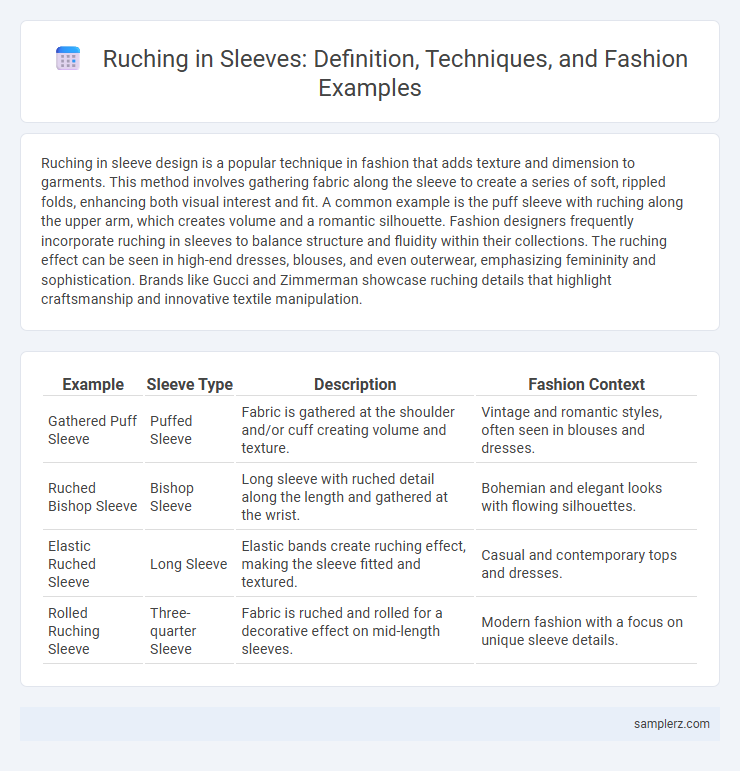Ruching in sleeve design is a popular technique in fashion that adds texture and dimension to garments. This method involves gathering fabric along the sleeve to create a series of soft, rippled folds, enhancing both visual interest and fit. A common example is the puff sleeve with ruching along the upper arm, which creates volume and a romantic silhouette. Fashion designers frequently incorporate ruching in sleeves to balance structure and fluidity within their collections. The ruching effect can be seen in high-end dresses, blouses, and even outerwear, emphasizing femininity and sophistication. Brands like Gucci and Zimmerman showcase ruching details that highlight craftsmanship and innovative textile manipulation.
Table of Comparison
| Example | Sleeve Type | Description | Fashion Context |
|---|---|---|---|
| Gathered Puff Sleeve | Puffed Sleeve | Fabric is gathered at the shoulder and/or cuff creating volume and texture. | Vintage and romantic styles, often seen in blouses and dresses. |
| Ruched Bishop Sleeve | Bishop Sleeve | Long sleeve with ruched detail along the length and gathered at the wrist. | Bohemian and elegant looks with flowing silhouettes. |
| Elastic Ruched Sleeve | Long Sleeve | Elastic bands create ruching effect, making the sleeve fitted and textured. | Casual and contemporary tops and dresses. |
| Rolled Ruching Sleeve | Three-quarter Sleeve | Fabric is ruched and rolled for a decorative effect on mid-length sleeves. | Modern fashion with a focus on unique sleeve details. |
Introduction to Ruching in Sleeve Design
Ruching in sleeve design enhances garment texture by gathering fabric along the sleeve seam, creating elegant volume and movement. This technique is frequently applied to puff sleeves, bishop sleeves, and balloon sleeves, offering a visually dynamic and flattering silhouette. Popular in high fashion and casual wear alike, ruching adds intricate detail that elevates the overall aesthetic of dresses, blouses, and outerwear.
Historical Origins of Ruching on Sleeves
Ruching on sleeves dates back to the Renaissance period, where it was commonly used in European noble attire to create texture and volume in garments. This decorative technique involved gathering fabric into pleats or folds along the sleeve to enhance visual interest and signify wealth. Historical portraits from the 16th century often showcase intricate ruching as a symbol of craftsmanship and status in fashion.
Classic Examples of Ruched Sleeves in Haute Couture
Ruched sleeves are a hallmark of haute couture, exemplified by iconic designs from Chanel and Valentino that showcase gathered fabric creating volume and texture. These classic examples feature intricate hand-stitching techniques that add elegance and dimension while emphasizing the silhouette. The structured ruching on sleeves enhances both movement and visual interest, making it a timeless element in luxury fashion collections.
Modern Interpretations of Ruched Sleeve Styles
Modern interpretations of ruched sleeve styles frequently feature asymmetrical gathers and exaggerated volume, adding dynamic texture to contemporary fashion designs. Designers incorporate stretch fabrics and precise pleating techniques to enhance comfort and tailor the silhouette, emphasizing both aesthetic appeal and functionality. These innovations transform traditional ruching into bold statements on runway collections and ready-to-wear garments.
Popular Fabrics for Ruched Sleeve Effects
Ruched sleeve effects are commonly achieved using popular fabrics like chiffon, silk, and jersey due to their lightweight and stretchy properties. These materials allow for soft gathers and controlled volume, enhancing the sleeve's texture while maintaining comfort. Blends containing spandex or elastane are favored for their elasticity, which helps maintain the ruched structure throughout wear.
Step-by-Step Guide: DIY Ruched Sleeve Example
Create a ruched sleeve by first selecting a stretch fabric and measuring the desired length from shoulder to wrist. Sew two parallel lines of loose gathering stitches along the sleeve where the ruching will be concentrated, typically from mid-upper arm to wrist. Gently pull the threads to gather the fabric evenly, then secure the ends of the stitches to maintain the ruched effect, creating a stylish, textured sleeve detail.
Celebrities and Influencers Wearing Ruched Sleeves
Celebrities like Zendaya and influencer Chiara Ferragni frequently showcase ruched sleeves in their fashion ensembles, elevating casual and formal looks with this textured detail. The gathered fabric along the sleeves creates dynamic volume and movement, highlighting a trend embraced by A-listers for red carpet events and street style alike. This ruched sleeve trend not only adds visual interest but also accentuates arm contours, making it a favorite among fashion-forward icons.
Ruching Techniques: Gathered vs. Elastic Sleeves
Ruching techniques in sleeves primarily include gathered and elastic variations, each offering distinct textural effects and fits. Gathered sleeves typically involve fabric manually drawn into tight pleats or folds, creating structured volume and intricate detailing that enhances silhouette definition. Elastic ruched sleeves use stretch bands to evenly scrunch fabric, providing comfortable flexibility and a casual, softly contoured appearance suitable for everyday fashion.
Styling Tips for Outfits with Ruched Sleeves
Ruched sleeves add texture and dimension to blouses and dresses, creating a flattering silhouette that enhances arm contours. Pair ruched sleeve tops with high-waisted jeans or tailored trousers to balance volume and create a chic, modern look. Opt for minimalist accessories to let the sleeve detail stand out, ensuring a polished and stylish outfit.
Ruching in Sleeve Trends: What’s Next?
Ruching in sleeve trends continues to evolve, with designers incorporating asymmetrical gathers and exaggerated puffed details to add texture and volume. Innovative use of lightweight fabrics like chiffon and satin enhances the delicate, ruched effect, making sleeves a focal point in contemporary fashion. Future trends suggest a move towards sustainable materials and multifunctional garments featuring adjustable ruching for personalized fit and style.

example of ruching in sleeve Infographic
 samplerz.com
samplerz.com